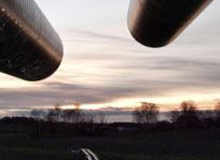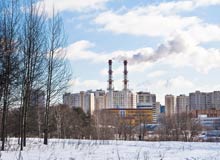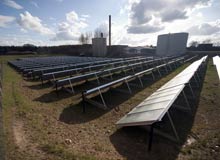The heat saving potential in the existing Danish building stock is between 70% and 80% of the existing heating demand. And to achieve a 100% renewable energy system in 2050, this heating demand should be reduced by 25% as a result of heat saving measures, demolition of existing and construction of new buildings, concludes a PhD dissertation by 4DH PhD Fellow Stefan Petrovic at DTU.
District heating and heat savings are especially important for the current as well as for the future Danish energy system, he concluded in the thesis, which he defended in October 2016.
“District heating expansion should start from the buildings located within existing district heating areas. Outside of district heating areas in Denmark, residential heat pumps are important heat supply options,” said Stefan Petrovic.

A new level of detail
He used Geographic Information System (GIS) and the energy system model TIMES-DK to analyse the development of the future Danish energy system.
“Use of GIS energy atlases on the local and national level was very important for my PhD work - for analysis of heat savings in the building stock, district heating expansion, finding optimal locations for new wind farms, creating cost curves and feeding them into energy system models. The energy atlases also proved to be useful for data storage and visualization,” said Stefan Petrovic.
TIMES-DK proved to be a powerful tool for analysing complicated interactions between energy demand, supply and energy savings, between short and long-term future, between different sectors, etc., but GIS gave the analyses a new level of detail.
“When analysing future heat supply, the interactions between heat supply and heat savings, as well as prospects for utilisation of biomass, wind, solar and waste, geographical information can play a very important role. For example, waste potentials are high in cities and towns, manure potentials are high in farming areas, average wind speeds are high in coastal areas, etc. The most important geographical aspect in the project is that the cost-effectiveness of the heat saving measures depends on the proximity to existing district heating and natural gas grids.”
Results are useful to the industry
During his PhD, Stefan Petrovic collaborated with both the Danish municipality of Ringkøbing-Skjern and the Danish Energy Agency, creating results which can be used by industry, supply companies and authorities.
“The district heating industry can use my research to identify areas for expansion of district heating, future heat supply, optimal levels of heat savings in the future under different assumptions, and efficiency improvements needed to obtain higher penetration of district heating in the future,” said Stefan Petrovic.
For example, if Denmark doesn’t follow renewable energy targets, the future district heating production will mainly be based on coal CHPs, with contributions from waste boilers, solar heating and waste heat. If Denmark continues towards 100% renewable energy system in 2050, district heating will mainly be produced from large-scale heat pumps, with contributions from solar heating, waste boilers and waste heat from production of biofuels.
As a part of the project, Stefan Petrovic created a very detailed GIS-based energy atlas of Ringkøbing-Skjern municipality, covering all areas of the municipal energy system: energy resources, transmission and distribution infrastructure, supply and demand, social data and other energy data. In his thesis, he shows how the energy atlas can be utilised for detailed analysis of heat savings in building stock, district heating expansion and finding the optimal location for new wind turbines. For example, he concludes that heat saving measures can reduce heating demand by 20–25%, while construction of new and demolition of existing buildings can reduce heating demand by another 2.5–3%. Read more here: http://www.sciencedirect.com/science/article/pii/S0360544216304522
See a video recording of the defense on YouTube: https://www.youtube.com/watch?v=0fsQ0VG-gBs.
Stefan Petrovic is now employed as a Postdoc in the Systems Analysis division, DTU Management Engineering, where he will continue to work on energy system models and GIS.

Heat saving potentials with annuitized full investment costs lower than 2 DKK/kWh specified according to geographical location.

Heat saving potentials with annuitized full investment costs lower than 2 DKK/kWh specified according to components of buildings' envelopes, construction periods and use of buildings.
TweetFUNDED BY
![]()







